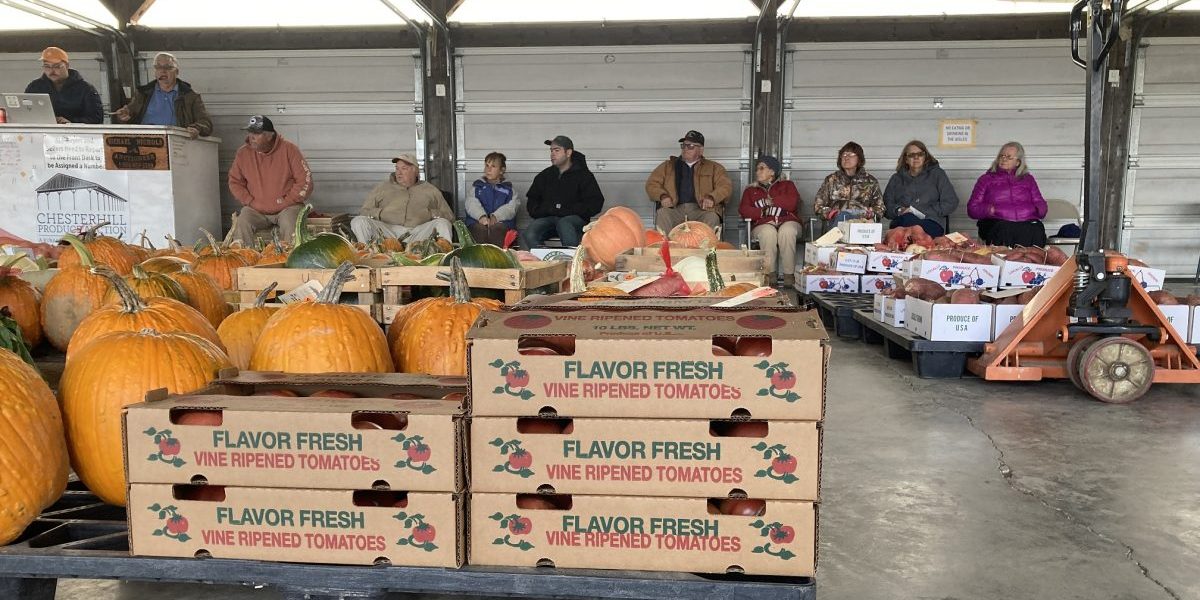News
An auction in rural Morgan County draws Southeast Ohioans with fresh, local produce
By: Theo Peck-Suzuki | Report for America
Posted on:
CHESTERHILL, Ohio (WOUB/Report for America) — People can get carried away at the Chesterhill Produce Auction.
Perhaps a box of purple sweet potatoes draws their attention. The bidding starts low, at $2. Now, it’s up to $7, and still rising. By now, the price doesn’t matter. The competitors want their prize, and they have only seconds to decide whether to call before they risk losing the sweet potatoes forever.
“That’s auction fever,” said attendee Thomas Schwendeman, a private buyer. “There’s a moment you can lose track of yourself.”
It all might seem a bit intimidating to those accustomed to buying food from the grocery store.
There are no price tags on any of the goods, and no way to know exactly what will be available on any given day (though the seasonal availability guide can help). The quantity can be overwhelming — some of the lots are packed with more apples or bell peppers than any one person can consume. And there’s the auctioneer, whose rapidfire speech catalyzes the already-stressful bidding process.
Nevertheless, the auction has become a fixture for the small community of Chesterhill and the many private buyers, resellers and community organizations who come from across the region to buy fresh fruits and vegetables.
One of those patrons is Allen Clark. He and his wife are regular attendees who can and preserve their own food.
“We used to do a large garden, and we just got to the point that it wasn’t as easy for us to do,” he explained. “We started coming over here because we could get a large quantity at a very reasonable price.”
And, he added, the quality of the produce is excellent.
“A lot of people like non-GMO foods,” he said. “And that is what they’re committed to raising here, too.”
Here’s how it works: Farmers drop their produce off at the auction. Volunteers, typically members of the local Amish community, set the goods out in rows underneath the auction’s large outdoor shelter roof. Each product is arranged by lot, and each lot has a designated number of units — typically half-peck boxes, but the container size varies.
Once the auction starts, the auctioneer leads attendees through the bidding lot by lot. Whoever places the winning bid on a lot chooses how much to take home — if 15 pecks of apples is too many, they might just take three. The remainder are then auctioned again or sold at the same price to other visitors.
A word of caution to newcomers: The price the auctioneer calls out is for a unit, not the whole lot. Taking more than one unit entails paying for each one. Additionally, some lots have a minimum number of units to take. That means just claiming one half-peck isn’t an option.
“There’s some people that get messed up on that,” said auction manager Jess Dotson. “[They] have to come up and say, ‘I did not mean to buy 50 pumpkins. I thought I was buying five.’”
She added, “If we catch it soon enough, we can try to help them.”
During the summer, the auction also has a number of smaller-scale lots specifically for consumers who don’t want to buy so much at once.

Once the bidding ends, however, people can be quite generous.
Schwendeman sometimes gets carried away and ends up paying a bit more than he intended for a lot. For him, that’s not important. Much of what he wins, he gives to charity regardless.
That’s feasible in part because the auction provides a venue for acquiring fresh, local produce below retail price.
“There are so many people I know from up in a big city like Cleveland who wish they could get something like what we eat here, and it’s just a fantasy,” he said. “It’s something they’ve read about.”
The potential of the auction to serve as an integral piece of a larger food ecosystem is not lost on others. As a social enterprise of Rural Action, it’s been designed intentionally to promote the social and environmental wellbeing of the region.
To that end, a number of organizations promoting affordable food access are regularly in attendance. One of those is Community Food Initiatives.
“I come out every Monday to bid,” said Reggie Morrow, CFI’s donation station manager. “The food that we get here today usually goes out to our Tuesday distributions,” as well as to the Athens County Food Pantry.
The auction also benefits the local Amish farmers who make up the majority of suppliers. It’s a convenient location for a population that can’t rely on cars or trucks to move goods.
“They’ve been there since the beginning,” Dotson said. “They volunteer every auction.”
And the auction aims to train the next generation of farmers through its ongoing participation in Rural Action’s Sustainable Agriculture program. That effort involves projects like a one-acre incubator farm, as well as a mentor workshop that pairs experienced farmers with newcomers.
“We go over business planning, what-to-do’s, what-not-to-do’s,” Dotson explained.
This year’s growing season is drawing to a close, which means next week is the last opportunity to experience the regular produce auction before April. The final auction on Oct. 27 will include a potluck and a workshop on growing a local food hub. Special consignment and holiday auctions are planned for the winter.

